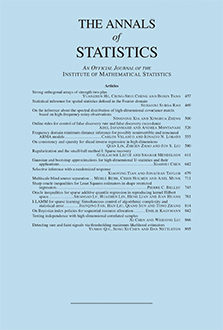Abstract
A sequence of independent random variables $X_1, X_2, \cdots, X_N$ is said to have a change point if $X_1, X_2, \cdots, X_n$ have a common distribution $F$ and $X_{n+1}, \cdots, X_N$ have a common distribution $G, G \neq F$. Consider the problem of testing the null hypothesis of no change against the alternative of a change $G < F$ at an unknown change point $n$. Two classes of statistics based upon two-sample linear rank statistics (max- and sum-type) are compared in terms of their Bahadur efficiency. It is shown that for every sequence of sum-type statistics a sequence of max-type statistics can be constructed with at least the same Bahadur slope at all possible alternatives. Special attention is paid to alternatives close to the null hypothesis.
Citation
Jaap Praagman. "Bahadur Efficiency of Rank Tests for the Change-Point Problem." Ann. Statist. 16 (1) 198 - 217, March, 1988. https://doi.org/10.1214/aos/1176350700
Information





